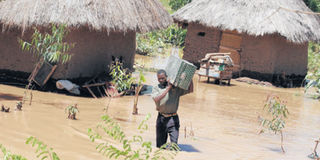Premium
Secondary school shut down after flooded classes pose disease threat

PHOTO | TOM OTIENO A resident of Bukhoba village, Budalang’i constituency leaves his flooded home on May 12, 2013.
What you need to know:
- River Nyando bursts its banks as number of people in need of help following days of heavy rainfall increases daily
Three schools have been closed indefinitely and nine others flooded after River Nyando burst its banks during heavy rains on Saturday night.
Learning has been paralysed in the schools, among them Ahero Girls Secondary School, Kokwach and Apondo primary schools, all in Kisumu County.
A spot check by Nation showed that classrooms, toilets and kitchens were submerged.
County Director of Education Beatrice Adu said the schools were closed due to health threat.
“The classrooms, the water pumps and kitchens were flooded, so we had to give priority to the health of the students due to the threat of water-borne diseases and pneumonia,” said Ms Adu.
Western Kenya Red Cross coordinator Emmanuel Owako said the situation was pathetic and the organisation overwhelmed.
“The number of the affected families is increasing daily and the more the rains continue, the more we are getting overwhelmed,” said Mr Owako.
Catholic University of Eastern Africa staff and students donated relief food and drugs worth Sh200,000 to flood victims in Nyando District on Sunday.
In Budalang’i, evacuation of those whose homes have been submerged began at the weekend.
High water levels
Lorries have been dispatched to the flood-prone area to ferry victims to safer ground.
Budalang’i district commissioner Khalif Ali Abdi and National Water Conservation and Pipeline Corporation site engineer Lucy Mbuthia regretted that residents were reluctant to move despite water levels reaching a record 6.12 metres.
Mr Abdi said six more boats bought by the Ministry of Special Programmes were on standby to evacuate families stranded in flooded homes.
“We have established a camp where the victims will have to put up.”
Ms Mbuthia said NWCPC was introducing measures that could solve the problem including use of gunny bags filled with sand to reinforce the strength of dykes.
NWCPC has constructed two mega dykes at River Nzoia to control flooding.
“Realignment of dykes that kept them much stronger than before equally played a critical role in containing the water as they are cushioned from pressure of flowing water,” she said.
Locals have petitioned the government to seek long term solutions to the floods menace.
“We want to know what happened to the World Bank multi-million-shilling project on River Nzoia that would have seen construction of dams to address this crisis once and for all,” said Mr Pius Mukola.
Water started sipping under the dykes at Igigo, Siginga, and Sibuka and Bukoba recently and displaced several families besides destroying houses and crops on over 2,000 acres.
Heavy rains continued to wreak havoc in Matungu and Mumias districts in Kakamega County, where several families have been forced out of their homes and learning disrupted in some schools.
Villagers evacuated
A bridge was swept away in Musanda, Mumias, making it difficult for residents to travel.
More than 100 houses and 20 toilets were destroyed in Matungu at the weekend.
In Murang’a, hundreds of Kiriko-ini villagers have been evacuated in anticipation of a landslide.
More than 200 villagers have abandoned their homes after huge cracks appeared on the ground and on the floors of their houses.
Several houses have also been brought down and roads rendered impassable.
Governor Mwangi wa Iria ordered the village to be sealed off to avert loss of lives after huge and deep gulleys appeared on farms.
On Sunday, Kahuro district commissioner Fred Muli confirmed that the residents had all moved and were putting up with relatives, friends and neighbours while others were staying at a church compound.
“Those who do not have a place to live in are being housed at ACK Church Gatuya,” said Mr Muli.
“We have also given them space to safely keep some of their household items,” he added.
Speaking to the Nation by phone, the DC said the residents’ livestock were still in the villages, adding to the nightmare of having to feed them during the day and leaving them alone at night.
The cracks appeared following days of heavy rains, raising fears of a landslide.
Mr Muli said geologists were expected any time to assess the extent of the damage and declare if it was safe for the villagers to return to their homes.
Some of the residents told the Nation that they had never seen such an occurrence before and described how they were woken up by the rumbling sound of the moving earth and the cracking walls.
Ms Catherine Wanjiru said she heard some rumbling noise last Wednesday night and later saw huge cracks on the walls and floor of her house.
Full of cracks
“I decided to evacuate my family after the cracks deepened and have been living in a friend’s house,” she said. The story is the same for her neighbour, Mr Phillip Muchumbi.
“I was awakened by what sounded like thunder only to see my house full of cracks which are widening by the day,” said Mr Muchumbi.
The government through the Disaster Centre has offered food aid while Governor Mwangi has set aside Sh500,000 to help the victims with food, bedding and drugs.
Reported by Angela Oketch, Everline Okewo, Linet Wafula, John Shilitsa and Samuel Karanja




